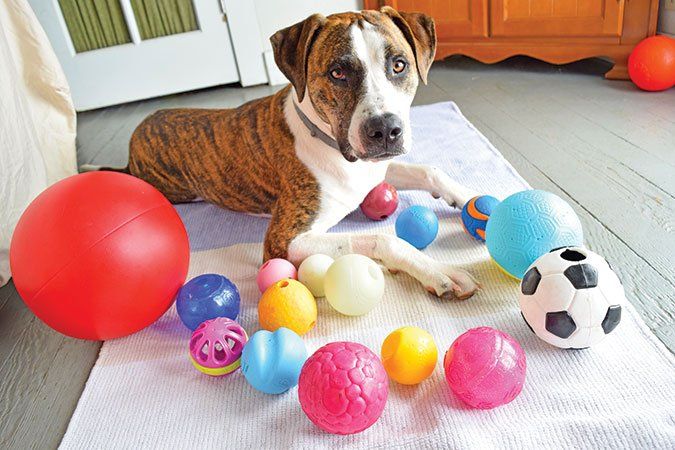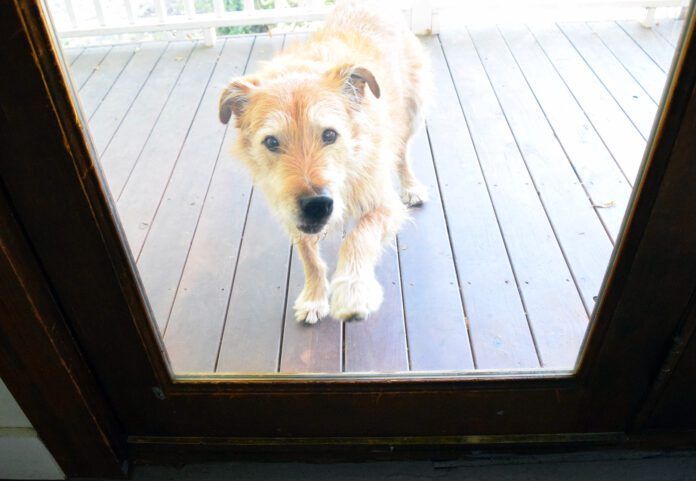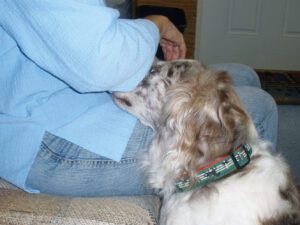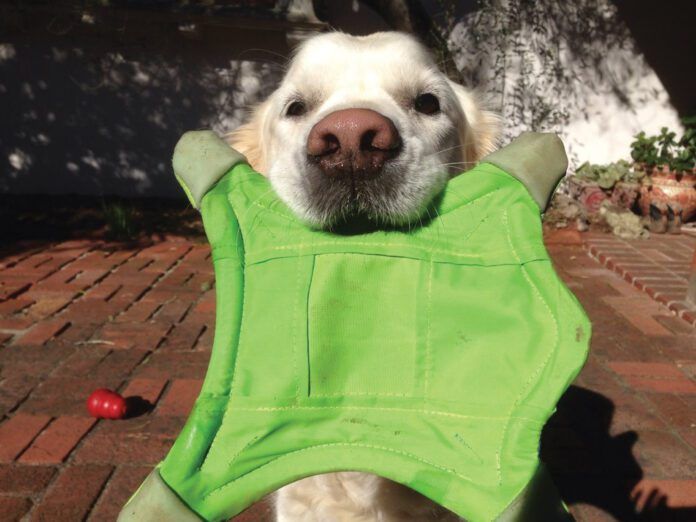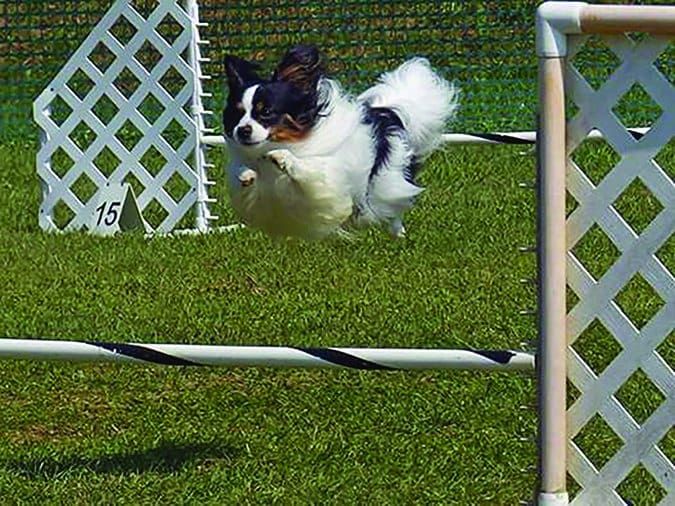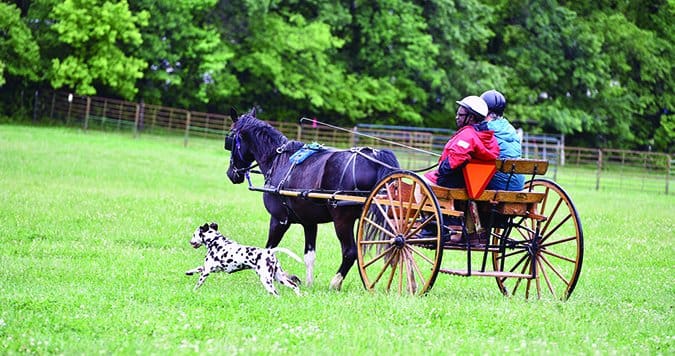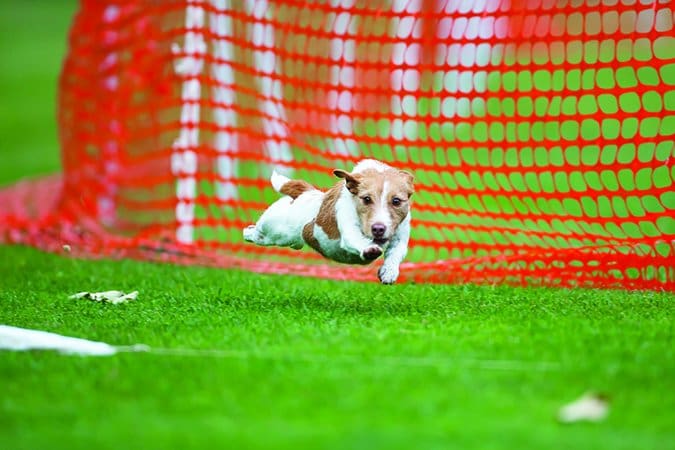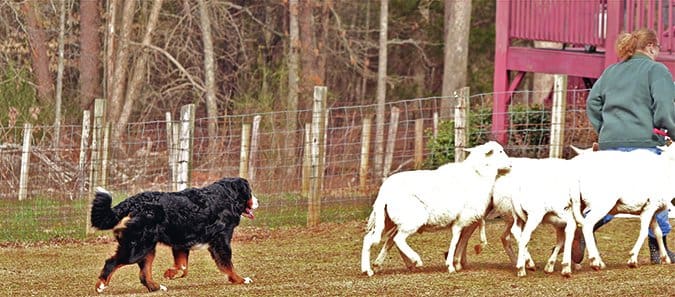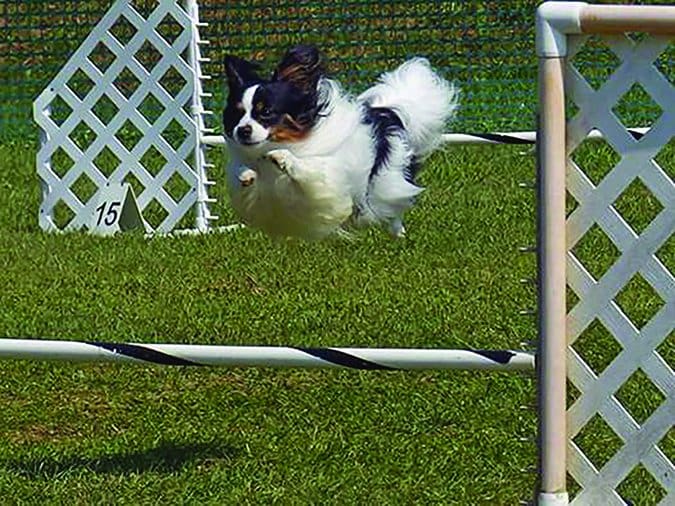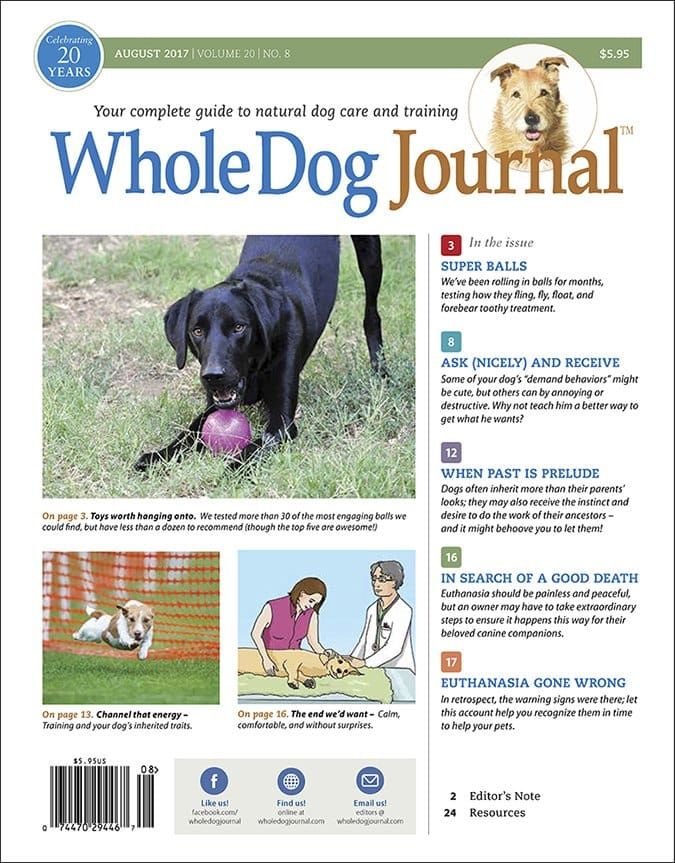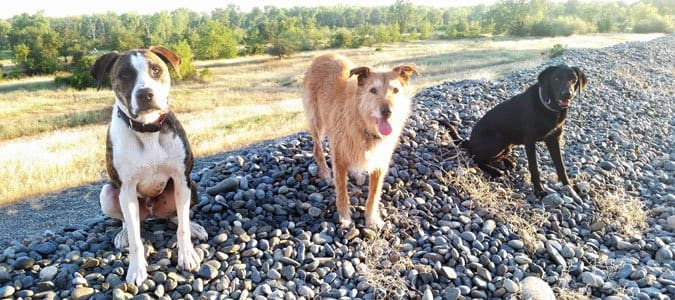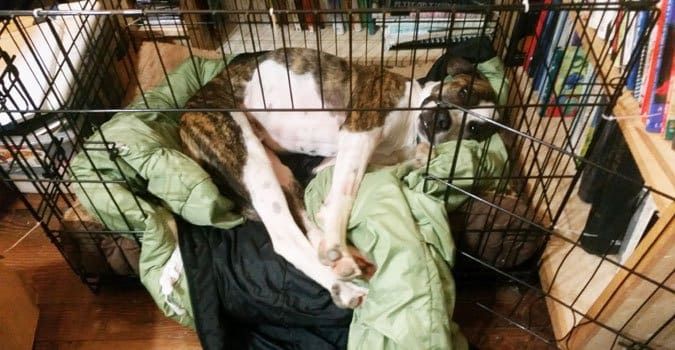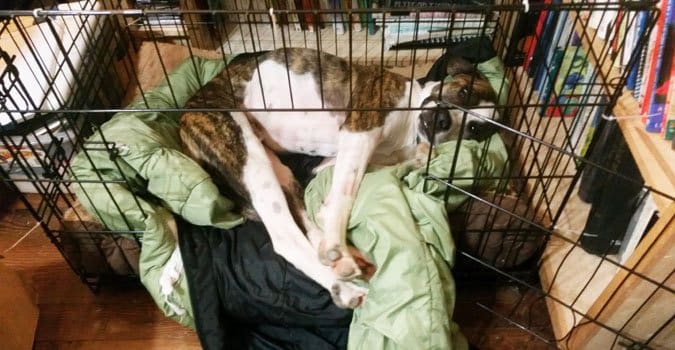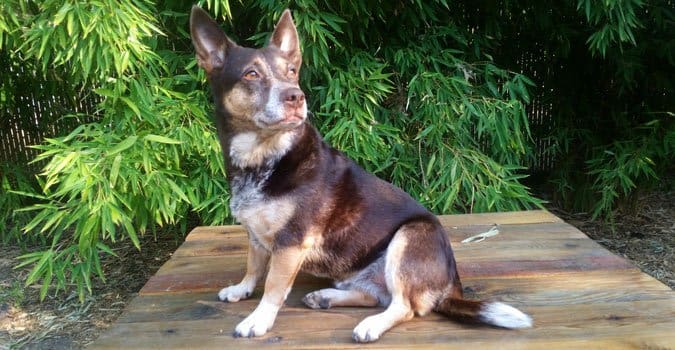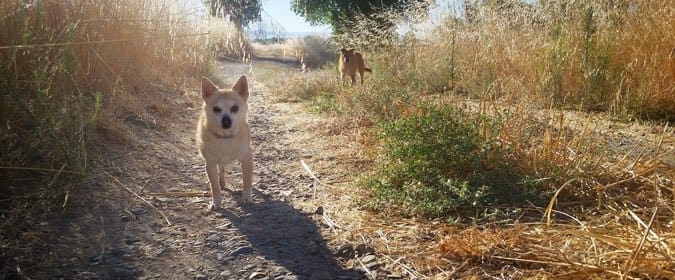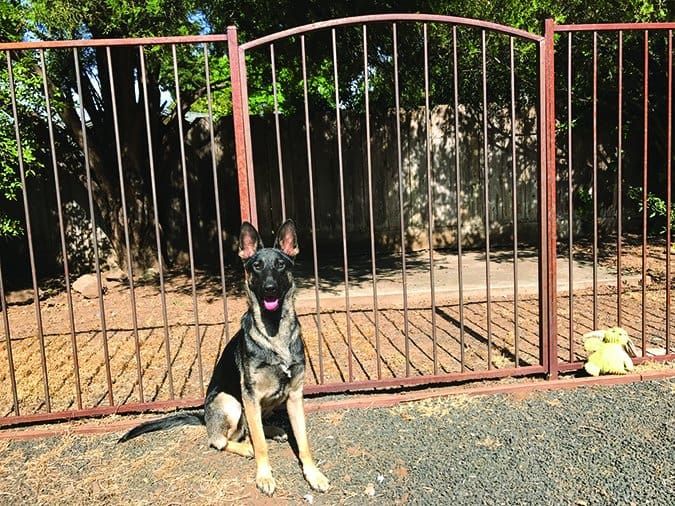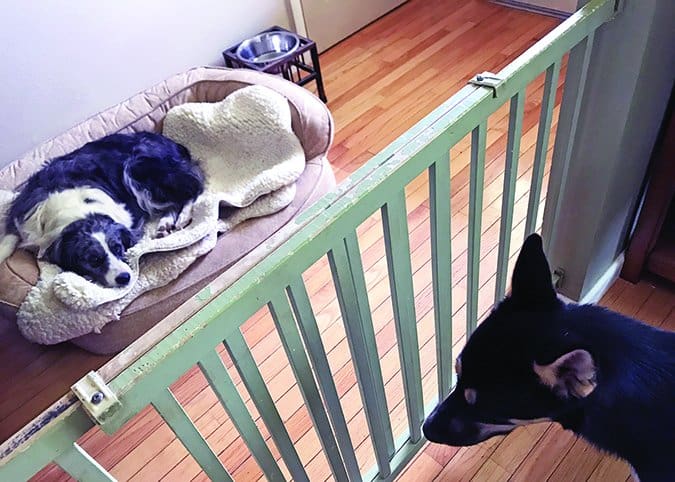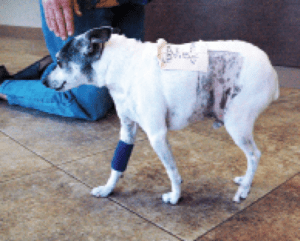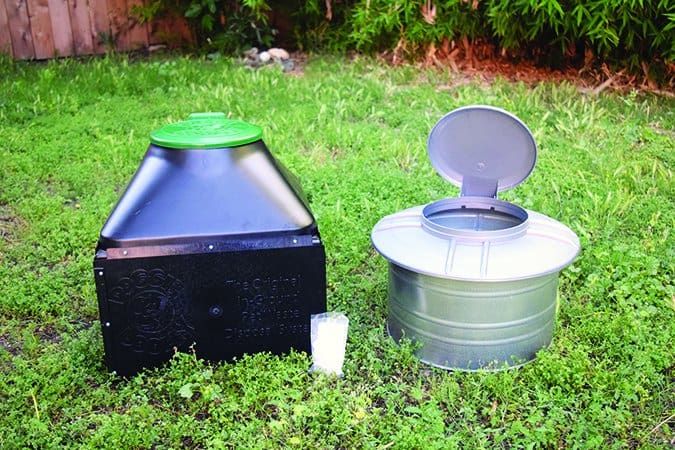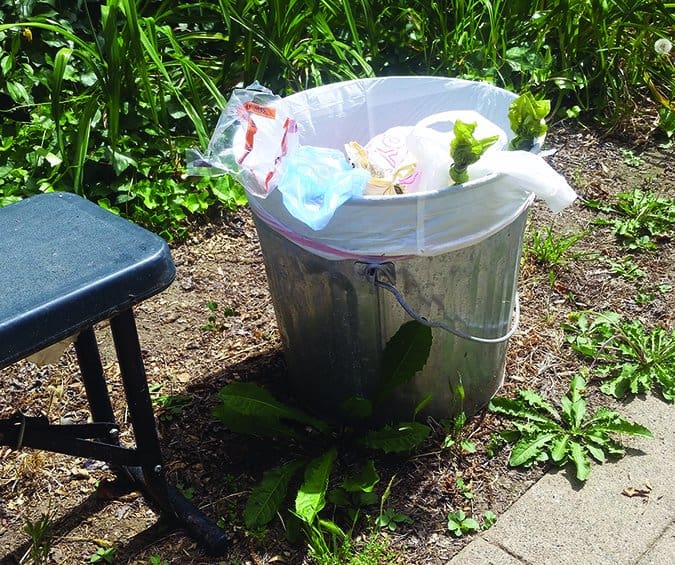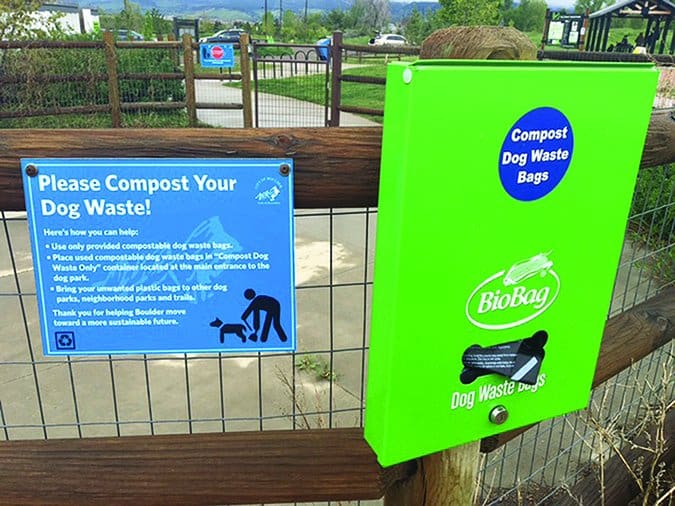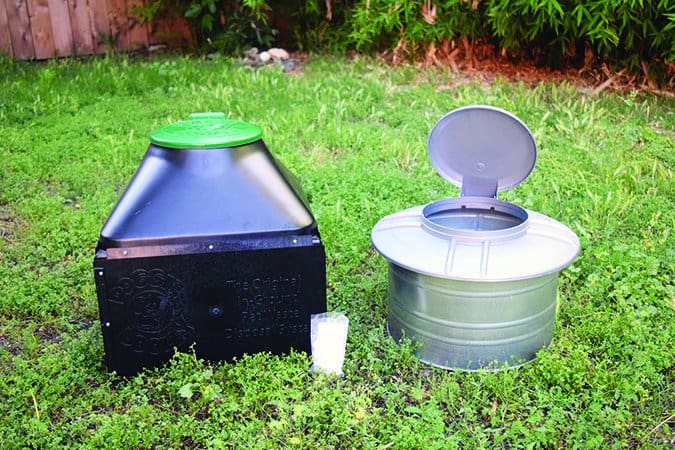Not long ago, I took a walk with my dogs, a friend, and her two dogs. Three of the four dogs trotted ahead of us in happy exploration. The fourth dog is a “fetch addict” – the kind who focuses all his attention on two things: a ball, and any nearby human who looks like she might throw the ball. He’s either chasing a ball, bringing it back, or imploring his human companions to “Throw it! Throw it! Please throw it!”
But I was distracted by keeping track of the dogs, conversation with my friend, and the gorgeous nature all around us, and I somehow managed to fling the ball in a crazy direction into some waist-high grass. It went so off-course that Woody, my Lab/pit bull-mix – you knew he was the fetch addict, didn’t you? – completely missed seeing where the ball flew or landed.
I apologized to my friend, telling her I’d have to interrupt the walk to help Woody hunt for the errant ball. After a few minutes of searching through the field of weeds, my friend asked, “Is it really that important that we find it? I have dozens of old tennis balls I can give you . . .”
“YES we have to keep looking!” I told her. “It’s a $17 ball!”
To which she responded, “How on earth can a stupid ball possibly be worth that much?”
Please allow me to count the ways!
Quality Dog Toy Buying Criteria
When we buy dog toys of any kind, we’re looking for a few traits:
1. Some irresistible quality that attracts the majority of dogs they are offered to
2. Durability, so they last long enough to pay for themselves in terms of the number of hours that they kept the dog happy and occupied
3. Safety, so they pose very little or no risk when used as directed
We don’t always consider the cost of a thing. Of course we want a decent value, but that’s from a durability standpoint, not just the price tag. We agree that $17 sounds like a fortune to spend on a ball. But given that some far less expensive balls don’t last 10 minutes, we consider $17 to be a bargain for a ball that lasts for months and months of only lightly supervised chewing, and consistently provides hours of entertainment.
And, yes, we consider Woody’s favorite ball, the $17 one we spent 15 minutes looking for in waist-high grass, to be a fantastic bargain.
Balls are the Best for Fetch
Not all dogs who like to play with balls like to fetch; some dogs just like to walk around mouthing their favorite toy, or pushing balls around the house or yard with their noses. Fetch addicts like Woody often regard balls as the fetch item of choice. Flying discs have their proponents, but balls offer certain advantages over other toys and fetch items:
- They usually have some bounce, providing opportunities to leap and catch them in the air.
- Being round, they roll, so a smart dog can find ways to amuse himself when no one else will play fetch with him, by dropping the ball down stairs, off the sofa or porch, or down a slope outdoors. Similarly, they can be batted with a paw and made to roll under furniture, giving a dog a great excuse to ask his owner for help (and maybe, just maybe, getting an extra throw out of the deal).
- Balls fly well through the air – not as well as discs, to be sure, but better than sticks or retrieving dummies, especially if a dog is lucky enough to have an owner with a Chuckit! or other ball-throwing assistance device.
- Balls often have a great “mouth feel,” and are fun for many dogs to just mouth, chew, or carry around.
Types of Balls We Were Looking For
When we started collecting balls to consider for our review, we realized there are many more types of balls than we could possibly include in a single review. We limited our selection to balls that could be thrown easily for dogs who like to fetch; we also included balls that had a little something extra to offer – additional features that engaged our test dogs and made them want to play with the balls even when no one else was playing fetch with them.
What are those “extra” features? Some of the balls have squeakers; one has crackly material inside. Most have a little – or a lot – of flex; you don’t want a dog leaping up to catch a ball that is hard enough to break teeth. We tested one ball that glows in the dark and one that has a light inside for use at night.
We didn’t include soft, stuffed (fleece-type) balls, nor balls whose primary purpose is to dispense treats. Note that a few of the balls we included could have treats inserted in them, but this isn’t the primary design purpose of the ball.
It should be noted that we were looking for balls for medium to large-size dogs. While there certainly are toy and small dogs who like to play with balls, selecting safe, appropriate balls for them to play with is not quite as critical, since their jaws are usually nowhere near as powerful as those belonging to larger dogs. In other words, it’s much easier to find toys for them to play with that they can’t chew up.
Many of the balls we selected for testing can be thrown with the help of a ball-flinging tool such as the Chuckit! or Planet Dog’s Wood Chuck. The Wood Chuck comes in only one size, and is designed to fling balls that are 21/2 inches in diameter – the same size as those used in classic Chuckit! launcher. Chuckit! is also available as a “large” ball launcher, meant to accommodate balls that are up to three inches in diameter. (We’ve noticed that it takes extra effort to jam these larger balls into the cup before flinging; they don’t fit quite as nicely as 2 1/2-inch balls fit into the Classic Chuckit!)
Safety First
It has to be said that playing with toys is an inherently risky activity for a dog. If there is a way to swallow something they shouldn’t, get some part of their anatomy stuck in something and hurt themselves, or get so swept up in play that they run into something, they will. Safety guidelines for playing with balls should include:
• Make sure your dog has access only to balls that are too big for him to swallow. If a ball seems a little small in your dog’s mouth, it probably does pose a choking or swallowing risk.
• Supervise your dog when he’s playing with any ball. Many products can be chewed up; if the pieces are swallowed, they pose a risk of choking or gastrointestinal problems (“just” vomiting if you’re lucky; blockages or perforation if you are not).
• We worry about products made from materials that may not be safe for dogs to chew on or swallow. For this reason, we prefer to buy balls that are manufactured in the U.S. and made with chemically inert materials. Not being able to find out what a ball is made of is a red flag.
• Watch that bounce! Play fetch with your dog only in areas where he isn’t at risk of following a bad bounce into a street or into a river with a swift current.
2017 Toy Ball Reviews
DOG BALL RATINGS AND REVIEWS |
||||
| 4 paws=As good as it gets. We strongly endorse the product. | 3 paws=A good product, with one or two significant flaws. | 2 paws=The product has some value, as well as some serious flaws. Some of its features may be useful in certain applications. | 1 paw=We are including the product only because of its potential for improvement. | 0 paws=The product has no redeeming value that we can appreciate. |
| PRODUCT | RATING | PRICE | SIZES | NOTES |
| Orbee-Tuff Squeak Ball Planet Dog Westbrook, ME (800) 381-1516 |
    |
$17 | 3″ | Patent-pending squeaker is molded into the center of the ball. Recyclable and free from latex, BPA, and phthalates. Material contains a small amount of essential peppermint oil for a subtle minty scent. Made in the U.S. |
| Orbee-Tuff Recycle Ball Planet Dog Westbrook, ME (800) 381-1516 |
    |
$15 | 3″ | Made from recycled bits of Orbee-Tuff material left over from molding other Orbee-Tuff toys, and recyclable themselves. Soft and squishy and yet exceedingly durable. Hollow and light, so it’s challenging to throw as far as some of the other balls. Made in the U.S. |
| Chuckit! Max Glow Ball Petmate Arlington, TX (877) 738-6283 |
   |
$4 – $11 | Small=2″ Medium=2.25″ Large=3″ XL=3.5″ | Very durable hollow ball; stiffer than the Orbee-Tuff toys but still squishable in the dog’s mouth. Glows in the dark for about 20-30 minutes after only about 5 minutes of exposure to light. Manufacturer says it’s made of rubber. Made in Vietnam. |
| Kong Squeezz Ball The Kong Company Golden, CO (303) 216-2626 |
   |
$3 – $5 | Medium=2.5″ Large=3″ XL=3.5″ | This ball is made of two pieces, one glued inside the other. The squeaker is built into the center of the ball; it’s not a separate piece that can be removed. Our test dogs were unable to destroy or disassemble this ball. Made in China. |
| Kong Squeezz Crackle Ball The Kong Company Golden, CO (303) 216-2626 |
   |
$3 – $5 | Medium=2.5″ Large=3″ XL=3.5″ | This ball is made of more than two pieces, one glued inside the other and containing some sort of crackly material in the center. Our test dogs were unable to destroy or disassemble this ball. Made in China. |
| Zogoflex Air Boz West Paw Design Bozeman, MT (800) 443-5567 |
   |
$10 – $15 |
Small=2.5″ Large=4″ |
Large size is too big for launchers like the Chuckit!, and is kind of heavy; we wouldn’t want a dog to get knocked on the head with an errant throw of this ball. This would be a great ball for a very large dog who ordinarily chewed up his toys; it’s too big to be easily chewed – and guaranteed against damage! Recyclable, BPA-, latex, and phthalate-free, non-toxic, FDA-compliant. Made in the U.S. |
| Rhinoplay Beast GoDog (a subsidiary of Worldwise, Inc.), Novato, CA (415) 721-7400 |
   |
$10 – $13 |
Jr.=3.5″ Large=5″ |
Junior size is difficult to find; large is too big for any except large dogs to pick up and carry. Very lightweight, unique, dense foam material. Ball is too lightweight to be thrown far – and yet very durable. Made in Taiwan. |
| Jolly Pets Bounce-n-Play Jolly Pets Streetsboro, OH (800) 232-7950 |
  |
$8 – $14 | Small=4.5″ Medium=6″ Large=8″ | These balls are not really for fetch, but are semi-soft, self-inflating, balls for play. They can be punctured and will still inflate. Company says its products are non-toxic and recyclable. Made in the U.S. |
| Chuckit! Firefly LED Ball Petmate Arlington, TX (877) 738-6283 |
 |
$11 | 2.5″ | It’s difficult to get the lights in the ball to turn on; fortunately, they turn off by themselves after 20 seconds of no movement. Very bright and fun to play with at night (on grass or other soft surface). Made in China. |
| Chuckit! Ultra Squeaker Ball Petmate Arlington, TX (877) 738-6283 |
 |
$4 – $8 | Small=2″ Medium=2.5″ Large=3″ | Bouncy yet squishy ball, made to fit in Chuckit! ball launcher. Dogs loved its squeak – but material was not durable enough to last beyond the first hour of play and chomping. Made in Vietnam. |
| Grinz Treat Ball Rogz Cape Town, South Africa |
 |
$5 – $7 | Small=2″ Medium=2.5″ Large=3″ | Outwardly, very similar to Orbee-Tuff balls: hollow and squishy. But the inexpensive material it’s made of is not at all durable. Calling it a “treat ball” is a stretch; it’s no more so than a number of the balls here. |
| Squeaky Ball Ruff Dawg Worcester, MA (800) 772-3726 |
 |
$6 | 3″ | Package calls it a “super tough toy” – it didn’t last one minute with our test dog. Made in the U.S. of non-toxic, recyclable material, a thermoplastic polymer. Made in the U.S. |
Top Pick Dog Balls
The balls that rose to the top of our review are ones that survived months of playing by fairly aggressive chewers without much more than cosmetic damage – and that the dogs themselves returned to play with again and again. There were a few balls included in our review that the dogs almost never selected to play with; for some reason, they were less engaging than the others. We retained these in the review and noted which ones they were; dogs with different preferences may enjoy them, though owners should take note that these toys were not tested as severely as the ones that got chewed daily.
The unequivocal favorite of all our test dogs is the Orbee-Tuff Squeak from Planet Dog. As the name suggests, this ball has a squeaker inside it, and after months of playing and chewing, not a single squeaker has been silenced nor chewed out of any of the balls. Planet Dog rates this ball as “durable” and we’d have to concur. It’s nothing short of amazing, really – hence our stubborn refusal to let a badly thrown ball go missing.
In addition to squeaking, the Orbee-Tuff ball bounces, floats, and is soft enough for a dog to enjoy mouthing and squishing for hours and hours. It’s made in the U.S. of a nontoxic material that is free of latex, BPA, and phthalates. It comes in just one size, a Chuckit!-compatible 21/2 inches.
Get this: All of Planet Dog’s balls, including the Squeak, are guaranteed. If they get chewed or destroyed, or if your dog doesn’t like them, you can return them for a replacement or a refund. Squeak!
At first glance, the Orbee-Tuff Recycle ball doesn’t seem like anything special. It doesn’t squeak or “do” anything unique. It’s a very soft, squishy, hollow ball – and all of our test dogs loved mouthing it like it was bubble gum. Because it’s so soft, it’s a great ball for catching in the air; it wouldn’t hurt any dog even if it bonked him on the head. At the same time, it’s incredibly durable. We have one of these balls that’s more than two years old and still hasn’t been chewed up.
The Recycle ball is so named because Planet Dog makes it from scraps of material left over from the other Orbee-Tuff toys; the material is melted down and mixed together, eliminating any waste. We applaud the earth-friendly approach! Like the other Orbee-Tuff toys, it’s free of latex, BPA, and phthalates, and can itself be recycled.
This is a relatively lighter-weight ball, so it’s difficult to throw as far as some of the heavier balls.

The Chuckit! Max Glow ball is also a chompable hollow ball, but the material it’s made of is a little stiffer than the Orbee-Tuff products, providing a bit more resistance to being squished in the dog’s mouth and flying farther when flung or thrown. It’s still quite durable, however; none of our test balls received any damage.
Obviously, the Max Glow is a great choice for playing fetch at dawn, dusk, or even at night. It “charges” fully with only about five minutes’ worth of exposure to a light source, and glows brightly enough to be easily found in the dark for 20 to 30 minutes. It comes in four sizes, with the smallest suitable for small dogs.
Best Toy Balls Runner-Up
This is Kong‘s version of a squeak-removal-proof squeaky ball. It’s made of two pieces that are glued together, with the squeaker molded into the center. This makes it sounds like it could be chewed apart, but none of our test dogs were able to do so.
This ball is a little stiffer and heavier than the Chuckit! Max Glow, so it throws nicely, but it’s still hollow and squishable enough to be squeaked to your dog’s delight. And it keeps squeaking even if the ball is punctured!
We love how Kong constantly innovates new products and supports the dog-training community. On the other hand, the Squeezz and the Squeezz Crackle are made in China, which we’re not wild about.
The Squeezz Crackle is also a squishable, hollow ball made of pieces that are (fortunately securely) glued together. The material has glitter of some kind embedded in it, and the center of the ball has some sort of crackly material inside. Kong says the material is “durable and nontoxic.” If our dogs were to chew this ball open, we’d remove it from them quickly. Fortunately, none were able to puncture it.
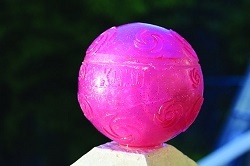
The Squeezz Crackle is lighter and squishier than the Squeezz Squeak, and all of our test dogs enjoyed chomping on it.
West Paw Design offers a lot of interesting and beautiful products for dogs, and this is one of our favorites. Zogoflex is West Paw Design’s proprietary blend of recyclable plastic; Zogoflex Air is less dense than Zogoflex; it’s slightly squishy and lighter, making it safer for a dog to catch in his mouth than Zogoflex.
West Paw says the material is latex-, BPA-, and phthalate-free, FDA compliant, and non-toxic.

It’s also highly durable. Our test dogs did their best to puncture or chew a piece off of this solid (not hollow) ball. After months of play, the ball has some tooth punctures in it, but is otherwise still intact. The ball is made in the U.S. and is guaranteed against dog destruction.
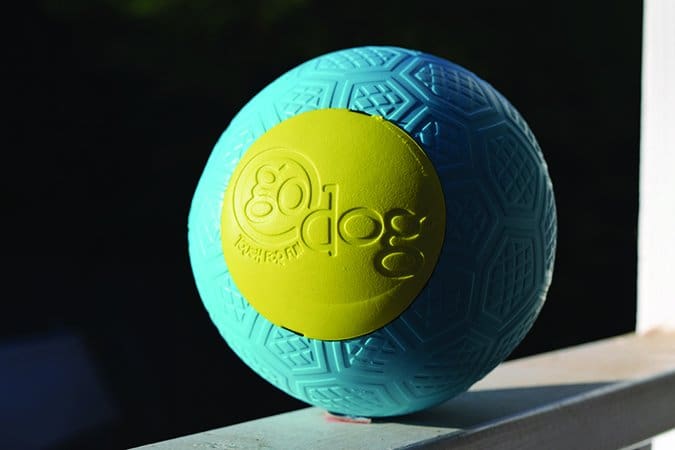
We first saw Rhinoplay toys at a pet products show last summer. We absolutely loved their light weight and unique, puncture-proof material. The company claims the foam is environmentally safe and nontoxic, and guarantees the product. If your dog doesn’t like it, or destroys it in a fit of enthusiasm, the company will replace it.
But even the small-sized ball is too big to fit into a ball launcher, and both balls are too light to throw very far, so neither is a great prospect as long-distance fetch items.
That said, our big test dogs really liked batting the toys around the house.
Jolly Ball‘s Bounce ‘n Play holds a similar appeal; it’s a hollow, semi-soft ball that can be punctured again and again but re-inflates by itself. It’s not really a good candidate for playing fetch, but the big dogs enjoyed knocking it around the house.
Easily Destroyed Balls
Then there were the balls that our test dogs really enjoyed – for a few minutes apiece. They are shown in the photo on the right, going clockwise from the left side.
• Chuckit! Firefly LED Ball: Just a few chomps, and the cap protecting the battery and light inside this ball had popped off. Once it was put back together, it was fairly difficult to get the light to turn on. It does light up beautifully, and is great for fetch on grass at night. If it bounced on hard ground, though, it’s likely the cap would fly off and you’d never find the pieces.
• Chuckit! Ultra Squeaker Ball: The squeaker was removed and the ball chewed up within an hour.
• Grinz Treat Ball: All the dogs liked the squishiness of this ball, but it had no durability whatsoever. It, too, lasted about an hour.
• Squeaky Ball: A super lightweight ball that might be fun for the very smallest canine fetch-fans out there. Our bigger dogs flattened it within a minute.
Nancy Kerns is the editor of WDJ. Her dog Woody chewed up all the balls shown here (and more).


